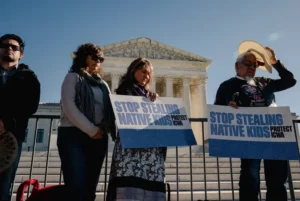 What began as a child custody lawsuit evolved into a lengthy hearing of four consolidated cases before the Supreme Court on November 9, 2022.1 The law in question is the Indian Child Welfare Act (ICWA) and the Court’s eventual ruling on it could impact laws about race, states’ rights, and the sovereignty of Native American tribes.2
What began as a child custody lawsuit evolved into a lengthy hearing of four consolidated cases before the Supreme Court on November 9, 2022.1 The law in question is the Indian Child Welfare Act (ICWA) and the Court’s eventual ruling on it could impact laws about race, states’ rights, and the sovereignty of Native American tribes.2
Why Did Congress Create the ICWA? What Does It Include?
Congress passed the ICWA in 1978 following over 100 years of federal policies such as American Indian boarding schools and the Indian Adoption Project. From the late 1800s through the middle-to-late 20th century, American Indian boarding schools aimed to assimilate Native American youth by forbidding tribal languages, beliefs, clothing, and names—a practice critics have labeled cultural genocide.3 From 1958 until 1967, the Indian Adoption Project operated with the stated goal of having Native American children adopted by white families.4
Extensive hearings and research prior to the ICWA’s passage showed that public and private child-welfare-oriented agencies had removed hundreds of thousands of American Indian children from their homes and placed 85 percent of them with non-tribal families.5 Few of these removals were due to abuse; most were based on social workers’ judgments that caretaking by extended family members (a common cultural practice in many Native American communities) demonstrated parental abandonment or that poverty (disproportionately present in Indian Country) amounted to neglect.6
In response, Congress passed the ICWA to stop a “white, middle-class standard” from dictating care decisions.7 The legislation set minimum standards for removing American Indian children (federal law uses the term “Indian” to refer to indigenous and Native American peoples of the United States).8 The ICWA also required states to notify tribes of an off-reservation American Indian child’s removal, and it set up a framework to give preferences for foster or adoption placements, first to extended family members, then to other tribal members, and subsequently to members of a different tribe—with some exceptions for “good cause.”9
ICWA arguments of supporters are that it has set a “gold standard” for other child welfare practices, both nationally and globally, especially with regard to its favoring of family placements.10 ICWA arguments from critics are that it places tribal needs over individual children’s needs by presuming that an American Indian tribe can always best serve the interest of an American Indian child.11 Other supporters contend that the ICWA especially benefits American Indian girls who are more likely than non-American Indian children to become human trafficking victims when placed in state foster homes.12 Still, state agencies and courts have often failed to enforce the Indian Child Welfare Act.13
READ part one of this blog’s series on the lead-up to the current Supreme Court case for more detailed historical context surrounding the ICWA.
Who Is Involved in the Current Case?
When a white Texas couple, Chad and Jennifer Brackeen, sought to foster and later adopt a 10-month-old Navajo and Cherokee boy, referred to in court as A.L.M., the ensuing legal battle led to a dispute over the boy’s half-sister, identified as Y.R.J.14 When the Brackeens learned that Y.R.J. would enter foster care, they filed for custody with the support of the child’s biological mother.15 An initial court ruling ordered shared custody between the Brackeens and Y.R.J.’s great aunt, who is of Navajo descent.16 Both parties appealed the decision, leading to the current Supreme Court case.17 In the meantime, Y.R.J., now 4, has lived with the Brackeens since infancy.18 According to Chad Brackeen, “It’s heartbreaking to us that there are laws out here that say it’s better for her to live in a tribal home, any tribal home … before she is allowed to stay in our home with her brother.”19
READ part two of this blog’s series on the lead-up to the current Supreme Court case for more information about the parties involved, the arguments at hand, and the prior legal steps of Brackeen v. Haaland.
What Could the Supreme Court Decide?
The case presents multiple legal questions that the Supreme Court may address.20 One is whether the ICWA can allow tribes to establish child placement preferences that state courts would have to follow.21 Texas argues that this unlawfully delegates a state’s legislative power to tribes, but President Joe Biden’s administration contends that the ICWA incorporates tribal preferences into federal law.22 Two related constitutional ICWA arguments also question state and federal authority: one asks if Congress’ Article I powers over Native Americans include child custody; the other asks if the ICWA violates the 10th Amendment’s “anticommandeering doctrine” by forcing state courts to implement a federal law.23
A separate legal question is over the Constitution’s equal protection guarantee, notably included in the 14th Amendment, which prevents racial, ethnic, and gender discrimination.24 The tribes and the Biden administration claim that the ICWA treats American Indians politically, based on their status as sovereign tribes, but the challengers argue that the law treats indigenous children and prospective adoptive parents on the basis of race.25 The distinction is significant because if the law is based on race, it must pass the stringent legal test of strict scrutiny rather than a lower bar called rational basis.26
What Implications Could This Decision Have?
Challengers to the ICWA note that Native American children are disproportionately represented in the foster care system, and they argue that the ICWA’s placement preferences add additional barriers between American Indian children and loving adoptive homes.27 “There are Americans out there who are eager to help these children out, and the Indian Child Welfare Act says they are not allowed to because their skin is the wrong color,” said Timothy Sandefur, an adjunct scholar at the libertarian-leaning Cato Institute.28 Texas Attorney General Ken Paxton wrote, “Knowing the difficulties that await them if they attempt to adopt a Native child, many couples simply turn elsewhere at the outset.”29
Kate Fort, director of the Indian Law Clinic at Michigan State University, said the Supreme Court’s decision could “lead to a fundamental re-understanding of how Congress can or cannot pass laws for tribes.”30 She pointed to a case in Washington, where challengers are echoing Brackeen’s arguments in opposition to an alleged gambling monopoly by Native Americans.31 According to Mary Kathryn Nagle, a Native American rights attorney, “For Indian country, it is maybe one of the most important cases that has ever gone before the Supreme Court.”32 Nagle has noted the oil and gas experience of the Brackeens’ law firm, suggesting it as a motivating factor in its work on the case.33 Robert Miller, a member of the Eastern Shawnee Tribe, tribal court judge, and Arizona State University professor of federal American Indian law, extended concern more broadly, saying, “All of a sudden, lands would be owned by ‘a race of Indian people,’ not a tribal government. Your borders, your police laws, everything on the reservation would be in question. I’m not being hyperbolic. I am afraid of this case.”34
What Did the Supreme Court Hearing Reveal?
Given the number of parties involved, the Supreme Court scheduled an extended hearing of one hour and 40 minutes, but the arguments exceeded three hours.35 Texas’s lawyer argued that Congress lacks the authority to enlist state governments in enforcing the ICWA, but Justice Sonia Sotomayor cited other laws with federal impact on state custody hearings, such as those involving deployed service members.36 Justice Amy Coney Barrett noted possible commandeering with regard to recordkeeping duties and the “active efforts” that the ICWA requires states to use to avoid breaking up Native American families.37 Justice Neil Gorsuch expressed disagreement, suggesting that since the “active efforts” provision applies to both state and private entities, it doesn’t attempt to co-opt state government.38 While Justices Barrett and Gorsuch, along with Justice Elena Kagan, indicated support for upholding Congress’s authority over American Indian affairs as “plenary,” or near-absolute, Justice Samuel Alito and Chief Justice John Roberts indicated concern that this could give Congress unlimited power over Native American law.39 In response, the Biden administration’s lawyer contended that Congress holds such power only if there is a rational relationship to Congress’ unique responsibilities regarding Native Americans.40
The “rational” standard seemed to draw criticism from justices who focused on race and equal protection questions, thereby implying a need for strict scrutiny in this case. Justice Brett Kavanaugh suggested Congress “couldn’t give a preference for white families for white children, for Black families for Black children, for Latino families for Latino children, for Asian families for Asian children.”41 The lawyer representing the Biden administration agreed that those decisions would be based on race but noted that the ICWA treated Native Americans as sovereign tribal entities rather than a racial group.42 Justice Kagan seemed to agree, noting the Supreme Court’s “long history of cases where we’ve understood legislation relating to the tribes as political.”43 Justice Sotomayor compared the ICWA to an existing international treaty that addresses child abduction and removal across national borders.44
Several justices questioned the racial/political distinction regarding the ICWA’s “third preference” that would place an American Indian child with a different tribe before a non-American Indian family.45 Justice Barrett said, “Let’s assume I agree with you that these are political classifications—this is just treating Indian tribes as fungible.”46 In response, the tribes’ lawyer noted that the Supreme Court could strike down that third preference alone and let the ICWA stand otherwise.47 He also said that the hypothetical transfer of an American Indian child from a tribe in Arizona to one in Maine “has never happened that we’ve been able to find or that counsel on the other side has been able to find.”48
Justice Gorsuch seemed to side with tribal lawyers over the implications of treating the ICWA as a race-based law, expressing concern that much of Title 25 of the U.S. Code (a section of laws governing Indian Country) wouldn’t survive an equal protection challenge.49 “There’ll be a lot that would be bitten out of Title 25,” said Justice Gorsuch. “We’d be busy for the next many years striking things down.”50
Justice Kavanaugh encapsulated the debate as a choice “between two fundamental and critical constitutional values.”51 On one side, Justice Kavanaugh described respecting tribal government and recognizing “the history of oppression and discrimination against tribes.” On the opposing side, he noted “the fundamental principle we don’t treat people differently on account of their race or ethnicity or ancestry.”52
How Does This Case Relate to Other Supreme Court Cases This Year?
Supreme Court observers have noted that many of the current term’s significant cases deal with race, either directly or indirectly.53 The Court has already heard cases on affirmative action and congressional redistricting (as related to the Voting Rights Act), and the December schedule features a case on the power of state legislatures over election law and voting restrictions (which often disproportionately affect people of color).54 Also in December, a case requesting a religious freedom exemption for a business that seeks to deny service to same-sex couples could see the Court discuss why that same exemption would or would not apply on racial lines.55
In the three cases the Supreme Court has already heard, one side was arguing for a “color-blind” application of the Constitution, to the perceived detriment of a minority group.56 In the Voting Rights Act case, for example, Alabama argued that a state cannot use race to benefit Black voters in drawing district maps.57 Supporters of a color-blind constitutional view see racial discrimination in all three cases, but opponents note that the post-Civil War Reconstruction amendments were never intended to be race-neutral but rather to use race-conscious laws to protect newly freed slaves.58 Those on both sides of the debate have pointed to the current makeup of the Court as potentially receptive to a color-blind constitutional reading.59
READ this blog’s posts on the Voting Rights Act case and the affirmative action cases for further discussion about this term’s Supreme Court cases focused on race.
What May Happen Next?
The ICWA has drawn significant support, with briefs in support of the law coming from hundreds of tribes and tribal organizations, over two dozen child welfare and adoption organizations, a bipartisan group of 87 members of Congress, and more than 20 states (ten of which have created state laws that mirror or exceed the ICWA’s standards).60 States could bolster those laws if the Supreme Court narrowly strikes down portions of the ICWA for federal overreach.61 Tribal advocates have said they will continue to fight for American Indian children, regardless of the Court’s decision.62
Based on the hearing, Supreme Court observers have speculated that Justice Gorsuch, a tribal rights proponent, could join with the three justices appointed by Democratic presidents in upholding portions of the ICWA, but that the group of four seems unlikely to draw the needed fifth justice to their side.63 A 5-4 ruling could chart a middle path that would uphold portions of the ICWA, strike down others, and avoid some of the far-reaching implications of a more sweeping decision. But such an outcome remains speculative until the Court issues its decision around June 2023.64
Discussion Questions
- During the hearing, Justice Kagan said, “The first thing you need for self government is a functioning polity,” and that Congress clearly “thinks that this statute is critical to the continuing existence of the tribe as a political entity.”65 In response, the Brackeens’ lawyer said that placing a Native American child with a white family wouldn’t change the child’s membership or reduce the size of the tribe.66
- How important do you think it is for Native American tribes to be given first preference to foster and adopt children that could be considered tribal members? Why do you think that?
- How important do you think it is for Native American children to be raised by extended family members or other members of their tribe? Why do you think that?
- Should state governments, the federal government, or tribal governments have primary jurisdiction over Native American children? Why?
- Do you think the ICWA should stay in place as it currently exists? Consider the following questions:
- Do you think the ICWA infringes on states’ rights to run their own adoption and custody systems? Why or why not?
- Do you think that having the federal government make laws about American Indian children is the best way to protect tribal rights? Why or why not?
- Does it discriminate against families like the Brackeens if a Native American child’s extended family gets preference over them to foster or adopt? Why or why not?
- Does it discriminate against families like the Brackeens if a Native American child’s tribe gets preference over them to foster or adopt? Why or why not?
- Does it discriminate against families like the Brackeens if a Native American tribe receives preference over them to foster or adopt a Native American child from a different tribe? Why or why not?
- Read the following two quotes to determine with which you agree more: “The precedent of the Supreme Court is that Indian tribes are political groups of people, they are not racial groups of people,” Chrissi Ross Nimmo, the deputy attorney general of Cherokee Nation, told reporters last month. “Tribes determine citizenship … just like countries.”67 Matthew D. McGill, a lawyer for the people challenging the law, said the children at issue had made no political choices. “They are human beings,” he said. “They are citizens of the United States and the states in which they reside. They are persons within the meaning of the Fifth Amendment. And they have liberty interests that the tribe cannot override simply by unilaterally enrolling them.”68
- Does giving preferential placement to tribes infringe on the liberty of American Indian children? Or would removing American Indian children from tribes do more to infringe on their liberty?
- The Brackeens are an Evangelical Christian couple.69 In a now-defunct blog, Jennifer Brackeen described religious inspiration for wanting to foster and adopt, and when it looked as though A.L.M. would be placed with a Navajo non-relative, Jennifer Brackeen wrote about how her family offered the boy access to their culture, which “he would not have had in his biological family.” By contrast, Sarah Kastelic, executive director of the National Indian Child Welfare Association, has said, “For a long time, non-Native people have been trying to ‘save’ Native children who don’t need saving.” Based on these quotes, consider the following question:
- Does having a religious motivation strengthen either party’s case? Why or why not?
- If you had final legal authority to determine the custody of now-four-year-old Y.R.J., how would you assign custody? To her great aunt of Navajo descent, to the Brackeens who adopted her half-brother, or to someone else? Would you prioritize any sort of shared custody? What factors most determined your decision?
- How concerned are you that this case could impact other laws about Native Americans? Why?
- Angelique EagleWoman, the director of the Native American Law and Sovereignty Institute at the Mitchell Hamline School of Law, refers to the ICWA as “a remedial statute because it has been the U.S. government’s policy for hundreds of years to destroy the Native American family.”70
- Do you think Congress should pass laws aimed at remedying past historical injustices? Why or why not?
- Do you think the Constitution should be read as “color-blind,” even if that disadvantages groups that some laws, like the ICWA, were historically created to protect? Why or why not?
Additional Resources
WATCH the Brackeens and Mary Kathryn Nagle (a Cherokee lawyer) comment on the case.
LISTEN to the Supreme Court hearing of Haaland v. Brackeen and consolidated cases.
WATCH “Blood Memory: A Story of Removal and Return,” an episode of “America ReFramed.”71 It presents an in-depth, first-hand account of a woman who was removed from her tribe in the Indian Adoption era and sought out her Native American culture as an adult. For a preview, watch the trailer here.
As always, we encourage you to join the discussion with your comments or questions below.
Sources
[12] Ibid.
[22] Ibid.
[23] Ibid.
[24] Ibid.
[25] Ibid.
[31] Ibid.
[38] Ibid.
[47] Ibid.
[50] Ibid.
[54] Ibid.
[55] Ibid.
[57] Ibid.
[58] Ibid.
[59] Ibid.
[62] Ibid.
[66] Ibid.
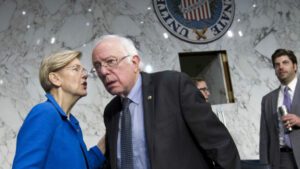
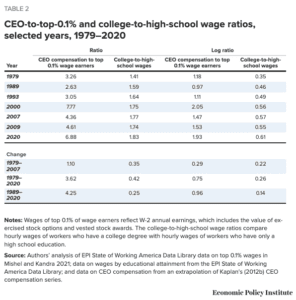
 The handling of sensitive information has become a headline-grabbing issue in recent months owed to the discovery of classified documents at the homes and offices of former President Donald Trump, President Joe Biden, and former Vice President Mike Pence. The political consequences of any judgment of wrongdoing on behalf of former President Trump, President Biden, and/or former Vice President Pence have introduced significant controversy into the national discussion of this issue. In light of this controversy, Attorney General Merrick Garland has established a special prosecutor for the Trump and Biden cases, who will work independently of the Department of Justice to determine whether any criminal conduct took place. Although a special prosecutor has not yet been appointed to investigate the Pence case, many experts see this as highly likely.1
The handling of sensitive information has become a headline-grabbing issue in recent months owed to the discovery of classified documents at the homes and offices of former President Donald Trump, President Joe Biden, and former Vice President Mike Pence. The political consequences of any judgment of wrongdoing on behalf of former President Trump, President Biden, and/or former Vice President Pence have introduced significant controversy into the national discussion of this issue. In light of this controversy, Attorney General Merrick Garland has established a special prosecutor for the Trump and Biden cases, who will work independently of the Department of Justice to determine whether any criminal conduct took place. Although a special prosecutor has not yet been appointed to investigate the Pence case, many experts see this as highly likely.1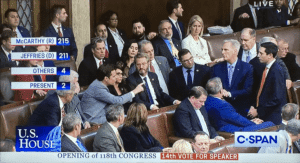 When the 118th Congress convened on January 3, what is usually a quick procedural vote for speaker turned into a contentious five days of voting on the floor of the House of Representatives.1 The frustrations, negotiations, and heated debates were on display on C-SPAN. Since the House could not adopt rules without a speaker—members-elect could not even take their oaths of office—C-SPAN cameras had a period of unprecedented access to roam the chamber, using three cameras to broadcast the proceedings without the usual constraints of House rules.
When the 118th Congress convened on January 3, what is usually a quick procedural vote for speaker turned into a contentious five days of voting on the floor of the House of Representatives.1 The frustrations, negotiations, and heated debates were on display on C-SPAN. Since the House could not adopt rules without a speaker—members-elect could not even take their oaths of office—C-SPAN cameras had a period of unprecedented access to roam the chamber, using three cameras to broadcast the proceedings without the usual constraints of House rules.
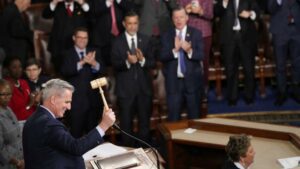 An under-the-radar rule change proposed by Democrats in the House of Representatives in the waning days of 117th Congress could potentially increase members’ yearly compensation. The provision, approved by the House Administration Committee, would allow reimbursement for a number of living expenses, including lodging, food, and travel in Washington, D.C.
An under-the-radar rule change proposed by Democrats in the House of Representatives in the waning days of 117th Congress could potentially increase members’ yearly compensation. The provision, approved by the House Administration Committee, would allow reimbursement for a number of living expenses, including lodging, food, and travel in Washington, D.C.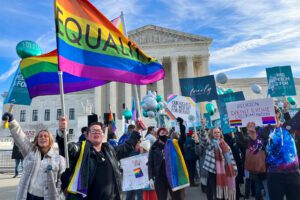
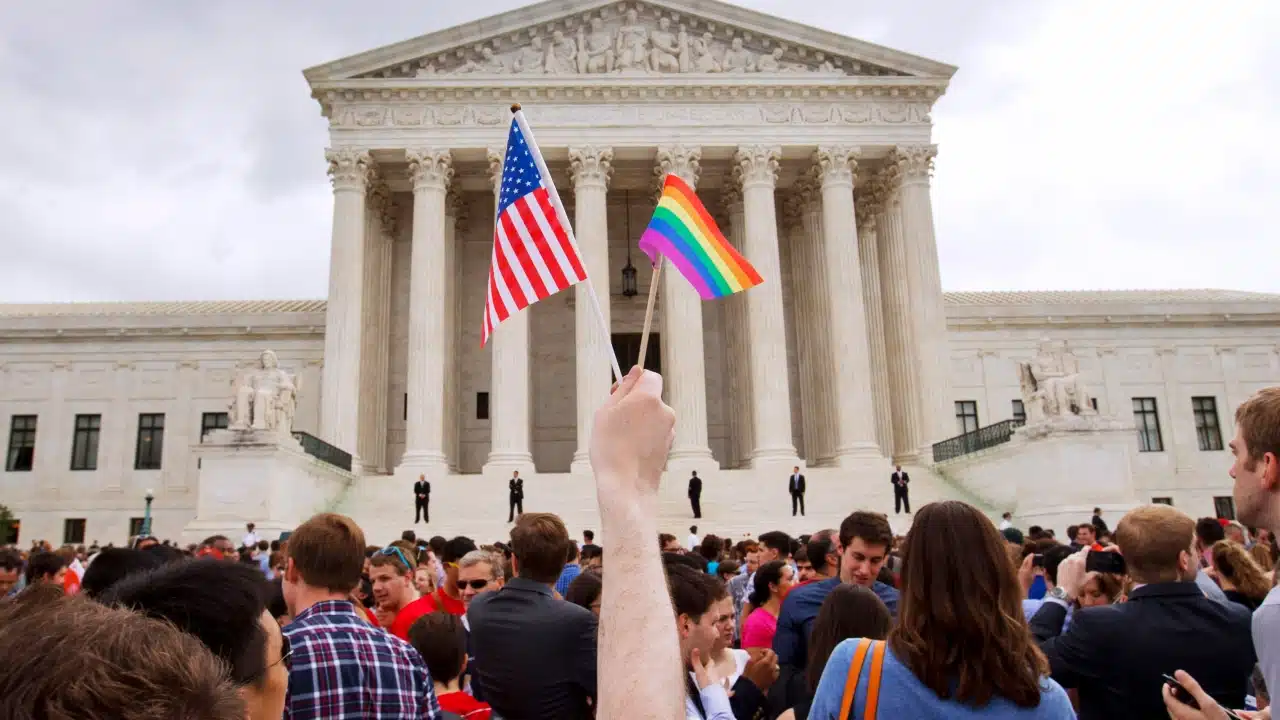
 What began as a child custody lawsuit evolved into a lengthy hearing of four consolidated cases before the Supreme Court on November 9, 2022.1 The law in question is the Indian Child Welfare Act (ICWA) and the Court’s eventual ruling on it could impact laws about race, states’ rights, and the sovereignty of Native American tribes.2
What began as a child custody lawsuit evolved into a lengthy hearing of four consolidated cases before the Supreme Court on November 9, 2022.1 The law in question is the Indian Child Welfare Act (ICWA) and the Court’s eventual ruling on it could impact laws about race, states’ rights, and the sovereignty of Native American tribes.2 By the end of the day on Election Day, 47 percent of eligible voters in the United States had cast a ballot in the 2022 midterm elections.1 After a week of waiting with several races still uncalled, heading to a runoff, or requiring a recount, it looks like Republicans will have a slim majority in the House of Representatives and Democrats will keep control of the Senate.2
By the end of the day on Election Day, 47 percent of eligible voters in the United States had cast a ballot in the 2022 midterm elections.1 After a week of waiting with several races still uncalled, heading to a runoff, or requiring a recount, it looks like Republicans will have a slim majority in the House of Representatives and Democrats will keep control of the Senate.2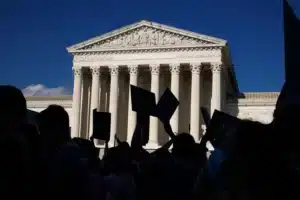 On October 31, 2022, the Supreme Court heard two cases regarding the use of race in college admissions.1 Rulings on these affirmative action cases could force many universities to reshape their admissions processes.
On October 31, 2022, the Supreme Court heard two cases regarding the use of race in college admissions.1 Rulings on these affirmative action cases could force many universities to reshape their admissions processes.






